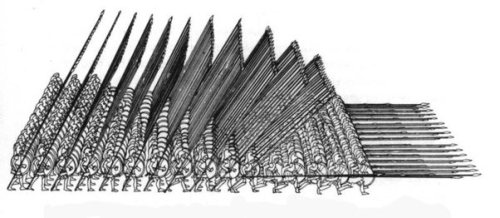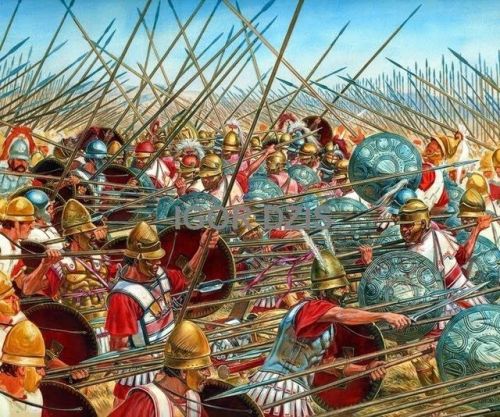The Evolution of the Roman Army Part I — The Roman Phalanx of the Late Kingdom and Early Repub
The Evolution of the Roman Army Part I — The Roman Phalanx of the Late Kingdom and Early RepublicAccording to legend Rome was founded in 753 BC by the semi-mythical figure Romulus and thus this can be said to also be the founding point of the Roman Army. This era of Roman history is shrouded in unknowns and what information is available is often mythical in nature, so there are not a lot of fine details on the structure of the Roman Army in this era. What is known is that the Roman Army was formed from warriors recruited from the three founding tribes of Rome, the Ramnians, Tities, and Luceres. According to Livy, the army consisted of 3,000 infantry and 300 horseman. It is unknown if the army used any special formations or tactics, but it is most likely combat was an unorganized affair by war bands led tribal chieftains, who in turn were commanded by the king, and the “Roman Army” basically brawled on the open battlefield.The Roman Army would become a structured and formally organized force under the reign of King Servius Tullius (R. 575-535 BC). Called the Servian reforms, Tullius made a number of decrees which reformed Roman society, politics, and the military. First the army was expanded to a force of 6,000 infantry and 600 cavalry, which was divided between two legions. Second the army was reorganized into an official fighting force with new organization and tactics. The phalanx was a tactical system made famous by the Greeks, a system in which heavily armed and armored soldiers would form a square formation several ranks deep, shoulder to shoulder, protected with interlocking shields and long spears which pointed towards the enemy. Since Greek culture had spread across the known world by the 6th century, the phalanx would become a popular tactic adopted by states and cultures throughout the Mediterranean. The new Roman Army created by Tullius was organized as a citizen militia structured around wealth and social class. Under this new system, only Roman citizens with a certain minimum amount of wealth could serve in the army. The bare minimum required owning property, personal possessions, and wealth totaling at least 11,000 asses (an ass was a small bronze coin). Soldiers were expected to provide their own weapons, armor, and equipment, and thus the ranks of the Roman phalanx was structured around social class, with the wealthiest Romans being the most heavily armed and forming the front ranks, and the poorest Romans being the least armed and forming the rear ranks. Romans who did not meet financial requirements were exempted from military service, however in times of emergency it was not uncommon for soldiers to be recruited from the lower classes, the state providing whatever weapons and equipment that was available. The highest social class in the army were the equites, a social class ranked only below that of senators and other wealthy Roman patricians with political offices. The equites became cavalrymen, being wealthy enough to not only equip their own arms and armor, but to equip and feed their horses as well. Typically the cavalry was placed on the flanks of the phalanx, and was used to either guard the flanks of the phalanx, attack the flanks of enemy formations, and chase down fleeing enemy soldiers.As for the infantry itself, the phalanx was structured on five classes. The first class were soldiers recruited from the wealthiest of Roman citizens (who were not of the senatorial class or equites), and thus had the best arms and armor. They were typically armed with a long spear, a sword, shield, helmet, a cuirass, arm guards, and leg guards (greeves). Being the most heavily armed, first class citizens which made up the front ranks of the phalanx were thus entitled to the most glory and honor on the battlefield. Second class citizens had less wealth and thus could afford less. Typically they were armed with a spear, sword or dagger, a smaller shield, and helmet, but lacked any other body armor. They typically made up the middle ranks of the phalanx. Third and fourth class citizens could afford even less, and thus typically had no armor, and were armed only with a spear, a dagger, and javelins. Located at the rear of the phalanx, they typically provided support for the front ranks by chucking volleys of javelins at enemy formations from the rear. Fifth class citizens were the poorest of Roman citizens who still qualified for military service. They were armed with a sling and stones (or lead bullets), and served as skirmishing troops.At the beginning of the battle the slingers would be deployed in front of the phalanx. If the phalanx was attacking the slingers would cover their advance by pelting the enemy with rocks. If defending they would harass the approaching enemy by pelting them with rocks. When close quarter combat was about to begin, the slingers would retreat to relative safety, and if possible provide support for the phalanx by, you guessed it, pelting the enemy with rocks.The phalanx would serve the Roman Army well into the late 4th century BC, with the Roman Army itself expanding to around 20,000-30,000 men. However the phalanx had several weaknesses that could be exploited. Phalanx formations were very slow and lacked mobility, making it fairly easy for light infantry and cavalry to outmaneuver them. Since the full force of the phalanx faced forward, a phalanx was almost always doomed when attacked from the flanks or the rear. In such cases, the phalanx couldn’t move quickly enough to redeploy to face an attack from a different direction, and thus would helplessly slaughtered. Finally the phalanx worked best fighting on flat grounds and open plains, a problem when the Romans would start expanding into the more rugged terrain of Southern Italy.To be continued… -- source link
#history#ancient history#roman history#roman empire#ancient rome#roman army#military history#phalanx

